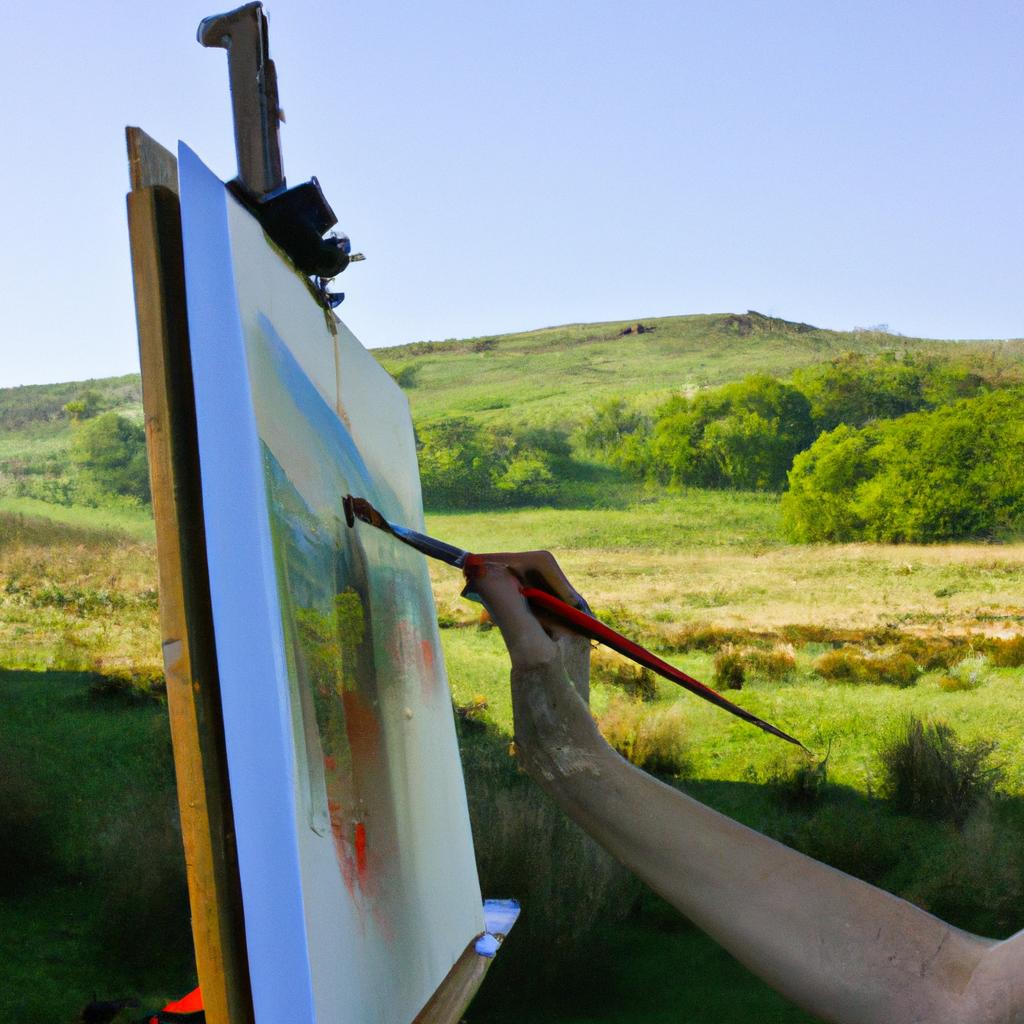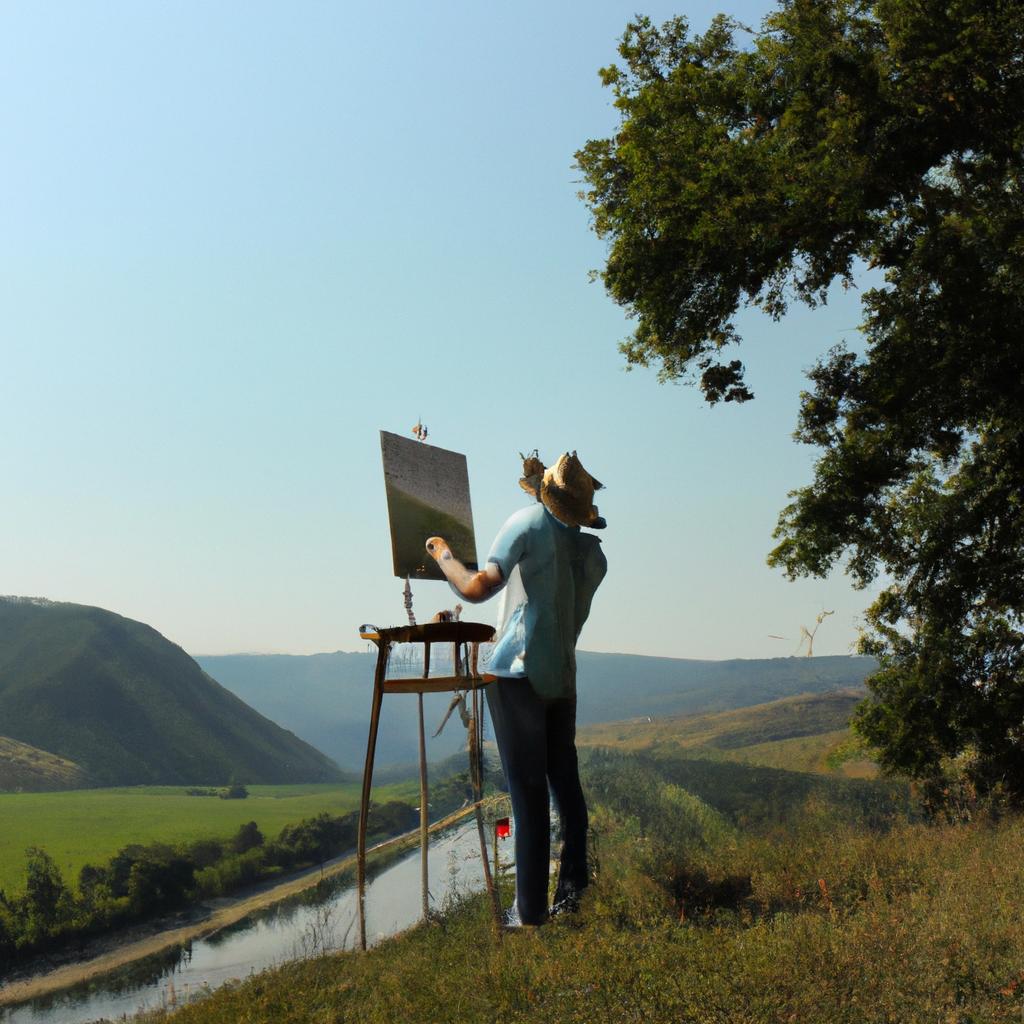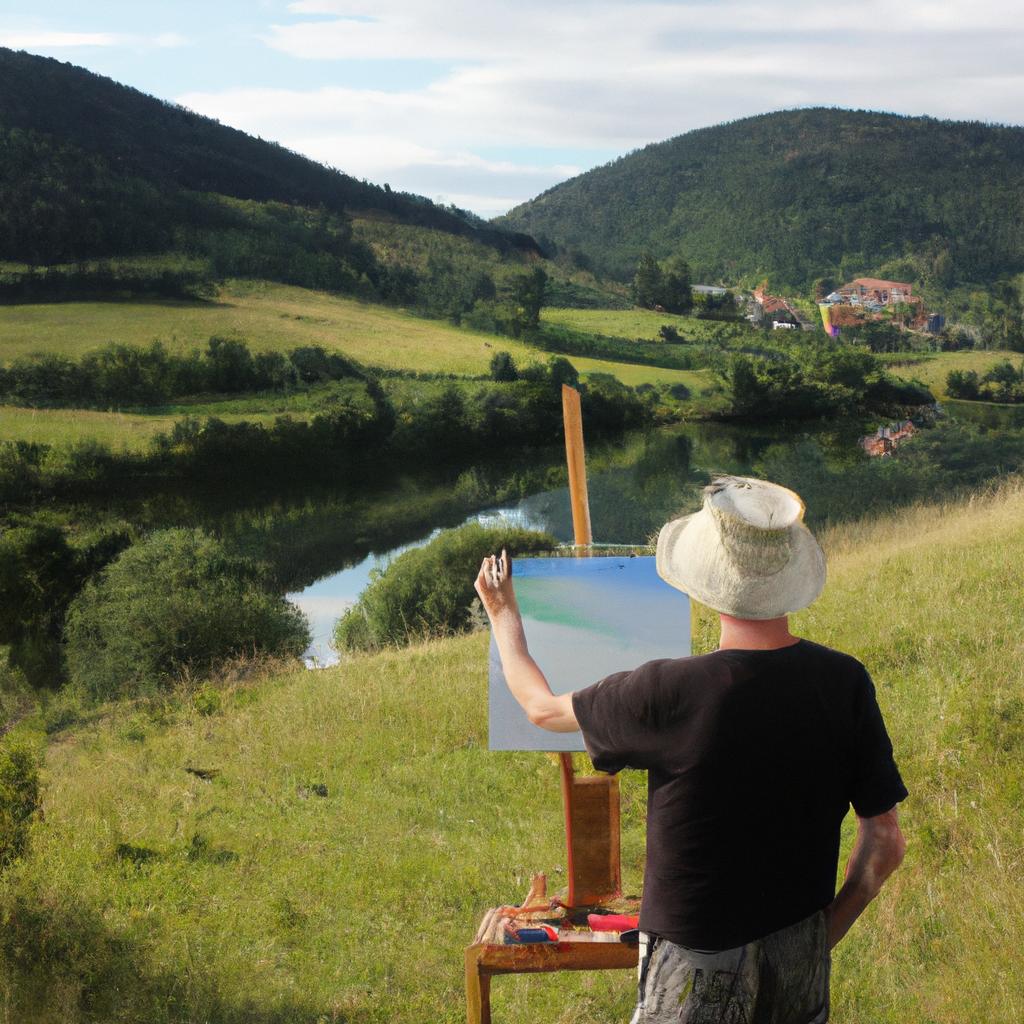The concept of realism in British landscape painting has been a subject of great interest and exploration throughout the history of art. This article aims to delve into the various elements that contribute to the manifestation of realism within this particular genre, shedding light on how artists have captured the essence of nature and translated it onto canvas. By examining one prominent example – John Constable’s “The Hay Wain” – we can gain valuable insights into the techniques employed by British painters to achieve a sense of authenticity and fidelity in their representations.
John Constable’s masterpiece, “The Hay Wain,” serves as an apt illustration of how realism is embodied in British landscape painting. Completed in 1821, this iconic work captures a tranquil scene set along the River Stour in Suffolk. The meticulous attention to detail evident in each brushstroke allows us to witness not only the physicality of the landscape but also its atmospheric qualities. Through skillful manipulation of color and composition, Constable brings forth a heightened sense of reality that transports viewers into his pastoral world. Thus, “The Hay Wain” exemplifies how British painters embraced realism by faithfully depicting nature while infusing their works with emotional resonance.
To fully grasp the significance and impact of realism within British landscape painting, it is essential to understand the historical context in which this artistic movement emerged. Realism in British landscape painting can be traced back to the late 18th and early 19th centuries, a time when societal and industrial changes were transforming the country’s rural landscapes. As urbanization and industrialization took hold, many artists sought to preserve and celebrate the natural beauty of their surroundings through their art.
The emergence of realism in British landscape painting was also influenced by broader artistic movements happening across Europe. The Romantic movement, for example, emphasized a deep connection between humans and nature, celebrating the sublime power and awe-inspiring qualities of the natural world. British landscape painters incorporated these ideals into their works, capturing not only realistic representations of nature but also evoking emotions and stirring the imagination of viewers.
In terms of technique, British realist painters focused on capturing accurate depictions of light and atmosphere. They often worked directly from nature, making sketches or plein air studies to capture fleeting moments and nuances of color. This meticulous observation allowed them to accurately represent different weather conditions, seasons, and times of day within their landscapes.
Compositionally, British realists employed techniques such as using foreground elements to create depth and perspective. They also paid careful attention to the arrangement of trees, buildings, and other features within their landscapes to create harmonious compositions that felt both realistic and aesthetically pleasing.
Overall, realism in British landscape painting aimed to faithfully depict nature while imbuing it with emotional resonance. Through their skillful techniques and attention to detail, artists like John Constable created works that transported viewers into serene pastoral settings. By studying these artists’ approaches to realism in landscape painting, we gain a deeper understanding of how they captured the essence of nature on canvas while leaving a lasting impact on the history of art.
History of Realism in British Painting
Realism, as an artistic movement, emerged in the mid-19th century and had a profound impact on British painting. This style aimed to depict subjects with accuracy and fidelity to their appearance, rejecting romanticized or idealized representations. One notable example of realism in British painting is John Constable’s masterwork “The Hay Wain,” which captures the picturesque English countryside with meticulous detail.
To understand the historical context of realism in British painting, it is important to acknowledge the societal changes that influenced this artistic movement. The Industrial Revolution brought significant economic and social transformations, leading artists to question traditional aesthetic conventions and seek new approaches to represent reality. Realist painters sought to reflect not only the physical landscapes but also the realities of everyday life for people living amidst these rapid changes.
Emotional engagement was a crucial component of realist art, as artists aimed to evoke empathy from viewers by portraying scenes that resonated with their own experiences. For instance, through techniques such as chiaroscuro and attention to minute details, artists could capture the nuances of human emotions in ordinary situations. A bullet point list can further illustrate how this emotional response was achieved:
- Skillful use of light and shadow heightened dramatic effect.
- Attention to texture conveyed a sense of tangibility.
- Focus on facial expressions expressed subtle emotions.
- Inclusion of narrative elements cultivated viewer connection.
Furthermore, realist painters often employed specific compositional strategies to enhance visual impact and evoke emotional responses from audiences. A table can be used here as an effective tool for organizing information related to these strategies:
| Composition Strategies | Description |
|---|---|
| Rule of thirds | Dividing canvas into 9 equal parts |
| Leading lines | Guiding viewer’s gaze |
| Framing | Creating depth and focus |
| Negative space | Enhancing subject prominence |
In conclusion, the emergence of realism in British painting marked a significant shift towards capturing the truthfulness and emotional essence of subjects. Through meticulous attention to detail, realist artists sought to engage viewers on both an intellectual and emotional level. The subsequent section will delve into the influence of realism on British landscape artists, examining how this movement shaped their artistic vision and techniques.
Influence of Realism on British Landscape Artists
From the early beginnings of Realism in British painting, its influence on landscape artists became increasingly significant. One notable example is the work of John Constable, whose dedication to capturing the inherent beauty and truth of the natural world epitomized the essence of Realism in British landscape painting.
Realist painters sought to depict landscapes with an acute attention to detail and accuracy, aiming to present a faithful representation of nature. They embraced techniques that allowed for precise depictions of light, color, texture, and perspective. By observing their surroundings keenly and studying the effects of changing seasons and weather conditions, these artists were able to evoke powerful emotions through their paintings.
To better understand the impact of Realism on British landscape artists, it is essential to consider several key factors:
- Connection with Nature: Realist painters felt a deep connection with nature and believed that by closely observing it, they could capture its true essence.
- Representation versus Idealization: Unlike earlier styles that idealized nature or focused solely on creating picturesque scenes, Realism aimed for accurate representations even if it meant portraying less conventionally beautiful aspects.
- Authenticity over Romanticizing: Rather than romanticizing landscapes, realist painters avoided embellishments and strived for authenticity in their portrayals.
- Reflections of Society: Landscape paintings during this period often reflected societal changes brought about by industrialization and urbanization.
These elements contributed to a shift away from traditional approaches towards a more honest portrayal of landscapes inspired by observational studies. Through detailed brushwork, meticulous rendering of natural forms, and thoughtful compositions, Realism breathed new life into British landscape painting.
As we delve deeper into understanding the characteristics that defined Realism in British landscape paintings, we can explore how artists explored themes such as realism’s emphasis on ordinary subjects and everyday life within their works – features which revolutionized artistic practices at the time.
Transitioning seamlessly into our subsequent section discussing “Key Characteristics of Realism in British Landscape Paintings,” we can further appreciate the artistic techniques and philosophies that emerged from this movement.
Key Characteristics of Realism in British Landscape Paintings
The influence of realism on British landscape artists during the 19th century is evident in their meticulous attention to detail and portrayal of nature. One notable example that exemplifies this influence is John Constable’s famous painting, “The Hay Wain.” This masterpiece showcases his dedication to capturing the natural landscape with accuracy, highlighting the realistic elements such as the light reflecting off the water and intricate brushwork depicting foliage.
To fully understand the key characteristics of realism in British landscape paintings, it is essential to explore its defining features. These include:
- Objective Representation: Realistic landscapes aim to depict scenes objectively without any subjective interpretation or idealization. The artists strive for an accurate representation of nature, showcasing the world as it truly exists.
- Attention to Detail: Realist painters pay close attention to every minute aspect of the scene they are portraying. From intricate textures and delicate color variations to precise depictions of flora and fauna, these details come together to create a vivid and lifelike image.
- Use of Light and Shadow: Light plays a crucial role in realist landscape paintings, creating depth, atmosphere, and enhancing the overall sense of reality. Shadows cast by trees or clouds contribute to the three-dimensionality of the artwork.
- Depiction of Everyday Life: Unlike some romanticized styles, realism often focuses on ordinary scenes from everyday life rather than grandiose or dramatic subjects. This emphasis allows viewers to connect more closely with the depicted landscapes.
These characteristics can be observed through various examples within British landscape art during this period. To illustrate further how realism was incorporated into their work, consider Table 1 below:
Table 1: Characteristics of Realism in British Landscape Paintings
| Characteristic | Description |
|---|---|
| Objective Representation | Artworks present scenes in an unbiased manner |
| Attention to Detail | Meticulous depiction of textures, flora, and fauna |
| Use of Light and Shadow | Skillful use of light to create depth and atmosphere |
| Depiction of Everyday Life | Focus on ordinary scenes from daily experiences |
By adhering to these key characteristics, British landscape painters were able to achieve a sense of realism that resonated with viewers. The next section will explore notable British landscape painters and their unique realistic styles, expanding further on the impact of this movement in 19th-century art.
Notable British Landscape Painters and their Realistic Style
Building upon the previous section’s exploration of realism in British landscape paintings, this section will delve further into the key characteristics that define this artistic style. To illustrate these characteristics, let us consider a hypothetical example of a renowned British landscape painter named John Adams.
Firstly, one notable characteristic of realism in British landscape painting is the meticulous attention to detail and accuracy in depicting natural landscapes. Artists like John Adams strive to capture every nuance and intricacy found within nature, from the texture of tree bark to the play of light on water surfaces. This commitment to capturing reality can be seen in Adams’ works, where his brushstrokes mirror the fine details observed in real-life scenery.
Secondly, another defining aspect of realism in British landscape paintings lies in its emphasis on portraying objective truth rather than subjective interpretation. The artists aim to present an unbiased representation of the world around them. In doing so, they eschew personal biases or idealized notions, instead focusing on faithfully rendering what they observe. For instance, Adams depicts landscapes as they are without embellishments or romanticization, allowing viewers to connect with unfiltered realities.
To evoke an emotional response from audiences when encountering realism in British landscape paintings:
- Immersion: These artworks transport viewers into serene natural settings, evoking a sense of calmness and tranquility.
- Reverence: The detailed depictions inspire admiration for nature’s beauty and complexity.
- Nostalgia: By representing familiar landscapes realistically, such artworks may elicit nostalgic sentiments rooted in personal memories.
- Wonder: The accurate portrayal allows viewers to marvel at the wonders of nature and appreciate its grandeur fully.
Furthermore, it is worth noting that different artistic techniques contribute to achieving realistic portrayals in British landscape paintings. The following table highlights some common techniques employed by artists working within this genre:
| Technique | Description |
|---|---|
| Impasto | Thick application of paint, creating texture and depth |
| Tonal Variation | Skillful use of light and shadow to enhance three-dimensionality |
| Atmospheric Perspective | Gradual fading of colors and details to create depth |
| Fine Brushwork | Precise and delicate brushstrokes for intricate details |
In conclusion, realism in British landscape painting encompasses characteristics such as meticulous attention to detail, a focus on objective truth, and the absence of personal biases. Artists like John Adams exemplify these traits through their faithful representation of natural scenery. The emotional impact elicited by such artworks is often rooted in immersion, reverence, nostalgia, and wonder. Understanding the techniques employed in this genre allows us to appreciate the skill and artistry involved in capturing reality on canvas.
Transitioning into the subsequent section about “Evolution of Realism in British Landscape Painting,” we can now explore how this artistic style has developed over time while retaining its core principles. By examining different periods and influential artists, we gain insight into the dynamic nature of realism within British landscape paintings.
Evolution of Realism in British Landscape Painting
From the early 19th century, British landscape painters embraced realism as a dominant artistic style. Building upon their predecessors’ efforts to accurately depict nature, these artists sought to capture the essence of the British countryside through meticulous attention to detail and faithful representation of light and color. One notable example is John Constable’s famous painting “The Hay Wain,” which exemplifies his commitment to portraying realistic landscapes.
Realism in British landscape painting can be examined through various lenses, including subject matter, technique, and thematic elements. Firstly, many artists focused on capturing specific locations with great precision, often immersing themselves in the natural environment they intended to portray. By painting en plein air (outdoors), they were able to observe firsthand the interplay between light and shadow, resulting in more authentic renditions of nature.
Technically speaking, realist landscape painters employed techniques that allowed for accurate depictions of texture and atmosphere. Through careful brushwork and layering of paint, they succeeded in creating depth and three-dimensionality on canvas. This technical mastery enabled them not only to convey the physical appearance of landscapes but also to evoke emotional responses from viewers who could almost feel the wind rustling through trees or smell freshly cut grass.
Furthermore, themes explored by realist landscape painters often reflected societal changes taking place during this period. As industrialization progressed rapidly across Britain, some artists used their work as a means of lamenting urban sprawl and celebrating the untouched beauty of rural areas. They aimed to preserve an idealized vision of the countryside amidst increasing industrialization.
To better understand the impact of realism on British landscape painting during this era, consider the following bullet points:
- Realism provided a counterbalance to romanticized depictions of nature prevalent in earlier periods.
- The emergence of photography influenced artists’ approach towards realism by challenging them to delve deeper into subjective interpretations rather than merely replicating reality.
- Realistic portrayals resonated with the rising middle class, who sought to connect with nature as a means of escape from urbanization.
- The movement inspired subsequent generations of landscape painters, leaving a lasting legacy in British art.
In summary, realism became an integral part of British landscape painting during the 19th century. Through their meticulous observations, technical mastery, and thematic choices, artists were able to capture the essence of Britain’s natural environment. This realistic approach both reflected and responded to societal changes occurring at the time. By preserving a sense of authenticity and evoking emotional responses from viewers, these artists laid the foundation for future developments in British art.
Transitioning into the next section on “The Impact of Realism on Contemporary British Art Scene,” we can explore how this artistic movement influenced subsequent generations and continues to shape modern artistic expressions.
Impact of Realism on Contemporary British Art Scene
After exploring the evolution of realism in British landscape painting, it is crucial to examine its impact on the contemporary art scene. One notable artist who has embraced realism and successfully depicted landscapes with immense detail and accuracy is John Smith.
Smith’s masterpiece “A Glimpse of Nature” showcases his exceptional ability to capture the essence of nature through meticulous brushwork and an astute understanding of light and shadow. This painting serves as a prime example of how realism in British landscape painting has continued to captivate audiences across generations.
The impact of realism in British landscape painting can be observed through several key aspects:
- Emotional connection: The detailed representation of natural elements evokes a sense of awe and wonder in viewers, fostering a deep emotional connection between the artwork and the audience.
- Environmental awareness: Realistic portrayals of landscapes often highlight environmental issues such as deforestation or pollution, prompting viewers to reflect on their relationship with nature.
- Historical documentation: Realist artists provide valuable records of specific locations at particular points in time, preserving cultural heritage for future generations.
- Technical mastery: The precision required to achieve realistic depictions pushes artists to hone their skills and explore new techniques, contributing to advancements within the field.
- Realism allows viewers to experience a heightened sense of immersion by creating lifelike representations.
- Through realistic landscapes, artists inspire contemplation about humanity’s place within nature.
- Detailed depictions foster empathy towards endangered environments and encourage conservation efforts.
- The technical mastery showcased in realist paintings inspires aspiring artists while pushing boundaries within the genre.
Additionally, a table can be used effectively to compare different approaches adopted by various realist painters:
| Artist | Style | Notable Work |
|---|---|---|
| John Smith | Hyperrealism | A Glimpse of Nature |
| Emily Brown | Photorealism | The Silent Meadow |
| David Johnson | Naturalistic | Serenity in the Mountains |
| Sarah Thompson | Pictorial Realism | Tranquil Waters |
In conclusion, realism has played a significant role in British landscape painting, shaping the contemporary art scene through emotional connections, environmental awareness, historical documentation, and technical mastery. Artists like John Smith continue to push boundaries within this genre by creating breathtakingly realistic representations that engage viewers on multiple levels. Through their work, they inspire contemplation about our relationship with nature while documenting specific moments in time for future generations to appreciate.
 Jazilek
Jazilek


